How to Plan a Backpacking Trip in 12 Simple Steps
I recall vividly a few years back, puzzling over how to plan a backpacking trip. I found myself grappling with selecting the perfect destination, determining what essentials to pack for the trip, and mastering the art of backpack packing. It’s hard to believe that was me.
Immersing myself in the topic, I discovered that minimal planning often leads to increased spending, especially when time is limited. While the choice of where, when, and how to travel rests with you, I firmly advocate that some degree of planning significantly enhances your trip experience while keeping costs in check.
Neglecting certain planning steps could mean missed opportunities. Without proper planning, you might overlook securing cost-effective flights, comparing transportation options, estimating your trip expenses accurately, and potentially missing out on key attractions or activities.
Moreover, personally, I find that planning is the most enjoyable aspect of any journey: envisioning all the incredible experiences awaiting me upon arrival!
Whether you’re a novice backpacker or a seasoned wilderness explorer, thorough pre-trip planning is crucial for a successful backpacking adventure. With that in mind, there are several essential steps to consider when preparing for a backpacking trip.
In this blog post, I outline a 12-step guide on how to plan a backpacking trip, breaking down the process into manageable tasks to alleviate overwhelm and boost your confidence as you gear up for your next escapade. Whether you dream of trekking through the Coastal Trails along the Pacific Coast or exploring the Hang Nak Mountain Nature Trail in Thailand, this comprehensive backpacking guide will walk you through every detail, ensuring you’re well-prepared for your backpacking trip. Let’s delve into the planning process!
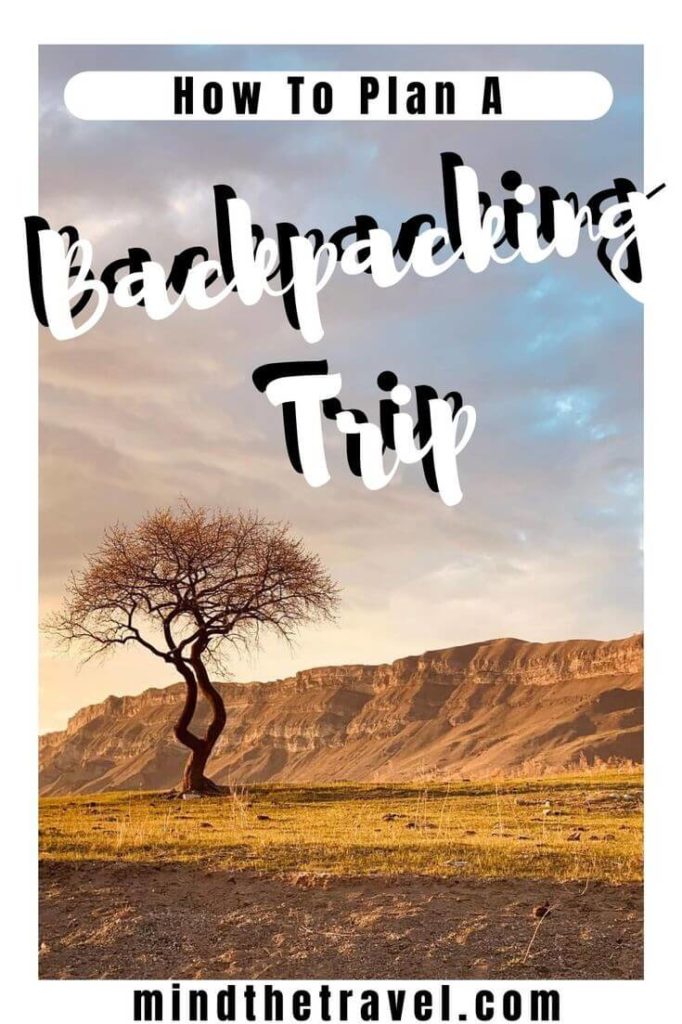
How to Plan a Backpacking Trip in 12 Simple Steps
1. Choose Your Destination
The first step in planning a backpacking trip is to choose your destination.
When faced with the exciting task of deciding where to venture next, the abundance of incredible destinations can be quite overwhelming.
Here are some key factors to ponder:
- Domestic vs. International: Consider whether you prefer a local or international expedition;
- Scenic Preferences: Do you crave the allure of mountains, deserts, lakes, or waterfalls? Define what sights captivate you;
- Daily Mileage: Determine your comfort level with miles per day—beginners might start with 5-7 miles, while seasoned backpackers may cover 8-13 miles daily;
- Trail Difficulty: Assess the trail’s complexity and total elevation gain to align with your skills and preferences.
Once you’ve selected a trail, initiate your research phase! Dive into blogs and engage with discussion groups on platforms like Facebook and Reddit, where backpacking enthusiasts can offer valuable insights and trip planning tips.
Consider pinpointing your destination based on climate, terrain, season, and accessibility.
Ecosystem Exploration
Delve into the ecosystem you wish to explore—be it desert landscapes, coastal regions, or mountainous terrain.
National Parks & Wilderness Areas
Compile a list of national parks and wilderness areas within your preferred ecosystems. They typically offer prime backpacking opportunities. Note that national parks often entail stricter regulations and more intricate permitting processes.
Whether you prefer daily backpacking or setting up a base camp, consider your hiking distance, companionship preferences (solo or group), and desired pace to ensure a fulfilling and safe backpacking experience.
2. Choose a Date for Your Backpacking Trip
Embarking on trip planning necessitates an understanding of when you intend to go. Here are key considerations:
Optimal Season
Depending on your destination, the best time of year varies. For mountainous regions, summer is ideal unless you fancy snow camping. However, be prepared for larger crowds during this period. For deserts or lower elevations, most times of the year are suitable, except for scorching summers.
Backpacking Trip Duration
Evaluate the length of your desired adventure. Are you seeking a brief weekend getaway, a few days off work, or an extended thru-hike experience? If you’re new to backpacking, starting with a one or two-night trip allows you to grasp what works best for you.
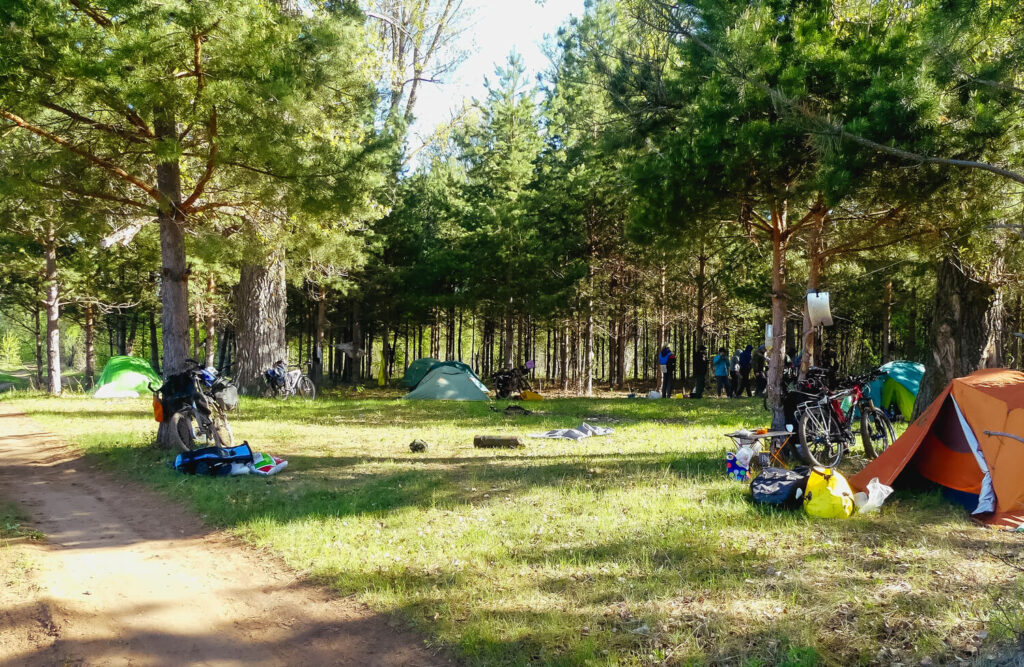
After addressing these factors, the next step involves selecting a trail that aligns with your established parameters.
Choosing the Right Trail
Selecting an appropriate trail is crucial and may require exploring multiple options before finding the perfect fit.
Research Tools
Utilize resources like topo maps, Gaia GPS, CalTopo, guidebooks, online blogs, and websites to identify potential trails. Topo maps provide detailed information, while guidebooks offer seasoned hikers’ insights and complete itineraries.
Online Resources
Browse the internet for backpacking itineraries and trip ideas tailored to various regions. A simple search for “best backpacking trips” in your desired area can provide a starting point.
Visitor Centers and Local Support
Seek guidance from rangers at state and national parks, who possess valuable insights on the best trails and backpacking routes in the region. Additionally, reach out to local gear shops and hiking clubs for expert advice and recommendations.
Remember, trip planning involves a degree of trial and error. The more you engage in this process, the more adept you’ll become at crafting memorable and seamless backpacking experiences. If you encounter challenges or confusion in selecting a trail, leverage these diverse resources to navigate and enhance your backpacking trip.
3. Create a Realistic Travel Budget
Determining your travel budget is a crucial step in planning a backpacking trip, as it varies significantly for each traveler. To approximate your expenses, consider factors such as your destination, planned activities, airline class (if needed), food, duration of stay, and accommodation options.
To get a rough estimate of your travel costs, tally up all potential expenses associated with your trip. By doing so, you can gauge whether the total aligns with your budgetary constraints. This preliminary calculation provides valuable insight into the financial aspects of your adventure and allows for better planning and decision-making.
4. Obtain a Permit for Your Backpacking Trip
Securing a permit is a vital step, particularly for popular trails, as it ensures compliance with regulations and enhances your overall backpacking experience.
Here’s a breakdown of permit requirements and processes to facilitate your planning:
Popular Trail Permits
The popularity of a trail often necessitates a permit. Some trails mandate backcountry permits booked months in advance, with lottery-based systems for highly sought-after routes. Consider alternatives like “walk-up” permits for trails where advance booking isn’t feasible.
Camping Regulations
Certain trails prohibit backcountry camping, requiring individual campground bookings for each night of your journey.
Public Land Permitting
Most trails are situated on public lands like national and state forests, parks, BLM land, Wilderness Areas, or county land. Permit details are typically available on state or national agency websites.
Backcountry Camping Permits
Some regions mandate permits for camping in the backcountry. Verify if your chosen trail necessitates one during your research phase.
National and State Park Permits
Backpacking in national or state parks typically requires permits, often accessible online via the National Park Service or relevant agency websites.
Wilderness Areas and National Forests
Permitting in these areas is usually more flexible unless heavily trafficked. Free permits are commonly available at trailheads, often without the need for advance arrangements.
Permitting Process
The permit acquisition process varies based on the specific area. Typically, you’ll need a permit for each designated campsite or camping zone for every night of your trip.
By understanding and adhering to the permit requirements for your chosen trail, you ensure a smoother and more compliant backpacking trip.
5. Arrange Transportation for Your Backpacking Trip
After securing time off, selecting your trail, and obtaining your permit, the next crucial step is arranging transportation.
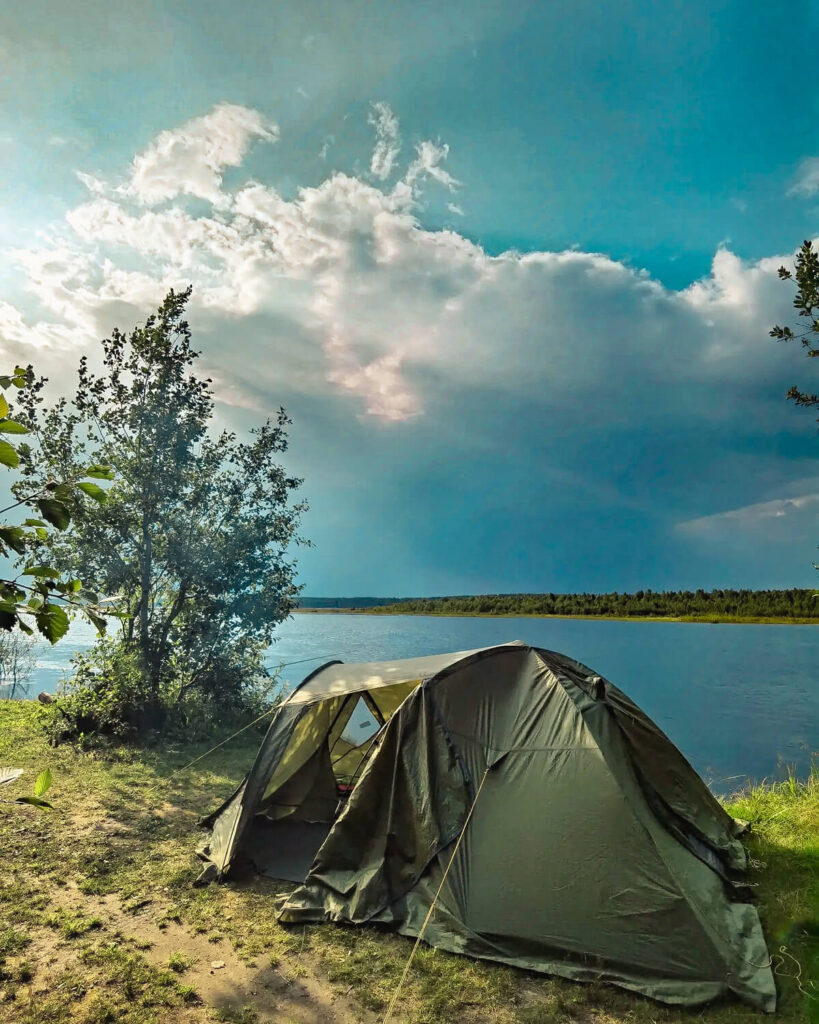
Here’s what you need to consider:
Transport Mode
Determine the transportation mode required. If flying is necessary, identify the nearest airport that facilitates your trail access. Consider renting a car upon arrival or check for available airport shuttles, especially in national parks.
Trailhead Parking
For loop or out-and-back trails, parking at the trailhead and concluding at the same spot is standard. However, for thru-hikes, several options exist.
Friendly Drop-Off
Opt for a kind friend to drop you off at one end and pick you up at the other, offering convenience.
Shuttle Services
Park a car at the end, utilize shuttles, flights, or hitchhiking to reach the starting point (or vice versa).
Dual Car Parking
Station a car at each end, necessitating a return journey to the trailhead post-hike, a less favorable choice when fatigued.
By organizing transportation effectively, you ensure a smooth and hassle-free transition to the trailhead, setting the stage for an enjoyable and stress-free backpacking trip.
6. Craft a Backpacking Itinerary
Creating a backpacking itinerary is crucial, especially for longer trips. For shorter trips, plan for 1 or 2 nights based on your daily mileage goals.
Here’s how to structure your itinerary effectively:
Day-to-Day Planning
For extended trips, outline achievable daily mileage and elevation goals, while remaining adaptable to unforeseen circumstances.
Consider incorporating an extra day for flexibility, accommodating slower progress or rest needs. Thru-hikers must also plan resupply stops, determining the days between each stop based on food storage limitations.
Utilize Trail Apps
Enhance your planning using apps like Guthook, Gaia, or AllTrails to grasp intricate trail details such as:
- Water sources;
- Resupply points;
- Camping zones;
- Elevation changes;
- Trail conditions.
By meticulously crafting your backpacking itinerary with these considerations in mind, you optimize your trip planning, enhance safety measures, and foster a more enjoyable backpacking trip.
7. Gather and Organize Your Backpacking Gear
Embarking on the gear collection phase is an exciting endeavor in your backpacking trip. Whether you are a novice or seasoned backpacker, investing in quality gear is essential for prolonged use. Consider the following guidelines to streamline your gear preparation:
Financial Considerations
While backpacking gear can be pricey, quality equipment offers longevity. For cost-effective alternatives, consider borrowing from friends or exploring options like REI Used Gear/Outlet for budget-friendly solutions.
Ultralight Gear
Ultralight gear tends to be pricier but can be advantageous for longer trips where weight is crucial. Every ounce saved contributes to reduced strain during your adventure.
Climate and Terrain Factors
Tailor your gear selection to the weather conditions and terrain of your destination. Gear requirements vary significantly between summer and winter camping.
Gear Preparation
As you finalize your trip plans, assemble your gear based on a standard backpacking checklist, adjusting items according to trip specifics.
Weather Considerations
Pack appropriate layers to accommodate fluctuating temperatures during your journey.
Gear Inspection
Lay out all your gear neatly on the floor to visually inspect and organize items. This method helps prevent overlooking crucial gear and allows for a thorough inspection of each item’s functionality.
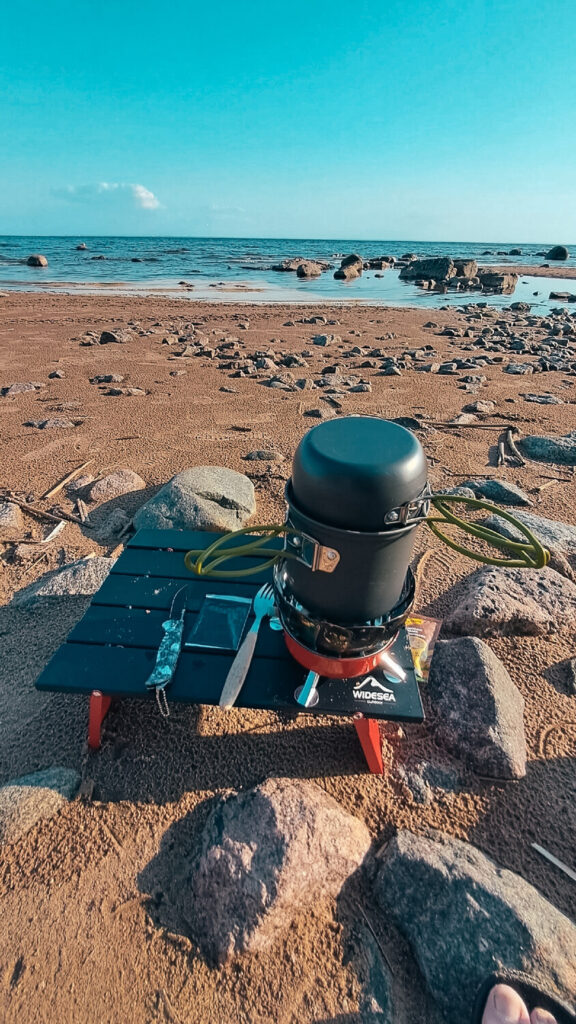
Gear Testing
Test each gear item meticulously, even if it means setting up your tent indoors or in your backyard. Ensure that every piece functions as intended for a seamless backpacking experience.
Personalized Gear Evaluation
Confirm that each gear item suits your specific needs. If necessary, exchange items for better-fitting alternatives.
Training Regimen
Break in your backpack and hiking shoes by embarking on short hikes to acclimate to your gear. Address any discomfort or fit issues early to prevent potential discomfort during your actual trip.
8. Create Your Backpacking Meal Plan
You can’t plan a backpacking trip without a meal plan. Designing a meal plan for your backpacking trip is essential for sustaining energy.
Here’s an overview of how to create your backpacking meal plan with efficiency and balance:
Balancing Act
Striking a balance between packing enough food without carrying excess weight is key. Opt for lightweight, shelf-stable, calorie-dense, and nutritious food items that are easy to prepare and clean up, given the lack of kitchen amenities while backpacking.
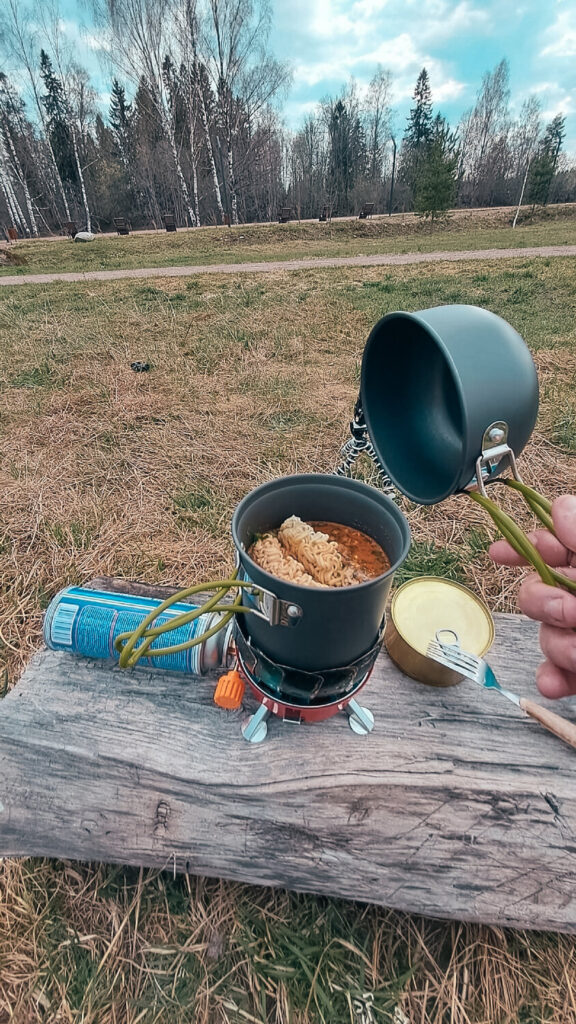
Key Considerations:
- Lightweight: Choose foods that are easy to carry, especially crucial for solo backpackers;
- Shelf-Stable: Prioritize non-perishable foods that remain safe above 40°F without refrigeration;
- Calorie-Dense: Select foods rich in calories, particularly fats, with a high calorie-to-weight ratio to fuel your energy needs;
- Nutritious: Opt for nutrient-dense foods to aid recovery, boost energy levels, and enhance overall well-being;
- Easy Preparation: Keep meal preparation simple, as you’ll be without running water and traditional kitchen facilities.
Meal Planning Tips
Dehydrated Meals
Consider bringing premade dehydrated or freeze-dried dinners for convenience and efficiency. You can purchase these from outdoor retailers or make them at home with a dehydrator.
Caloric Needs
Aim for 2,000-3,500 calories per day, adjusting based on activity level and personal factors. Opt for the lower range on lighter days and the higher end for strenuous activities.
Simplicity in Cooking
Simplify meal preparation by boiling water, adding it to your food, and allowing it to sit before consumption.
Healthy Options
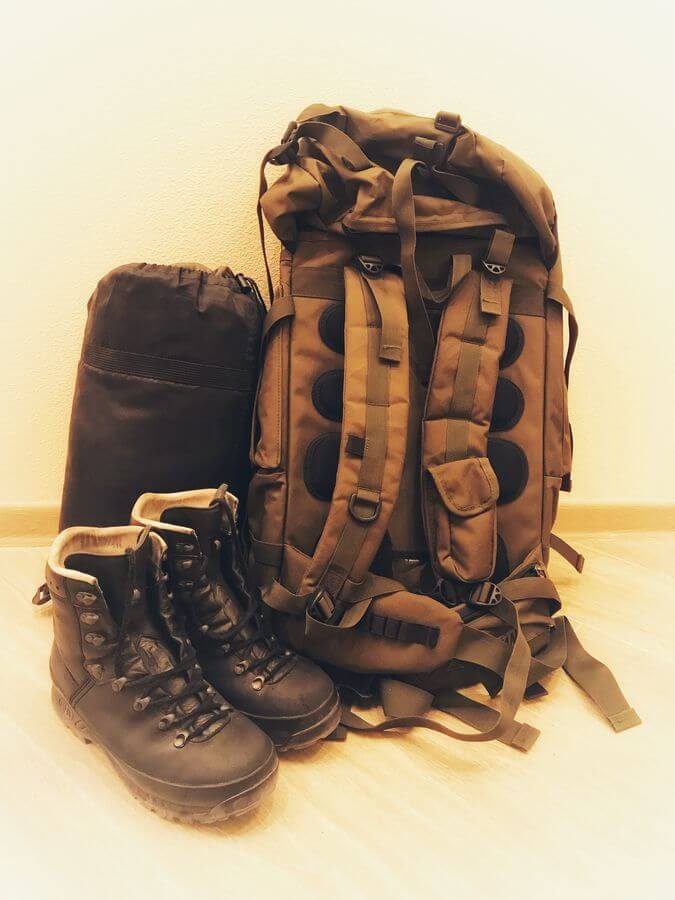
Include no-cook items like whole grain tortillas, bread, avocados, nuts, and seeds to enhance nutrition and complement dehydrated meals.
Variety and Texture
Incorporate diverse flavors (spicy, sweet, salty, sour) and textures (chewy, crunchy) to prevent meal monotony, especially with dehydrated meals.
By tailoring your backpacking meal plan to meet your nutritional needs and preferences, you’ll be well-equipped to enjoy flavorful, nourishing meals.
9. Understand Leave No Trace Principles
Preserving the natural beauty of the wilderness areas is paramount for sustainable outdoor experiences. Leave No Trace principles serve as a vital framework to minimize our impact on the environment and safeguard these pristine landscapes for future generations.
These guidelines encompass various aspects, including campsite selection, fire management, waste disposal, restroom etiquette, and wildlife interaction.
It is imperative to adhere to these principles to ensure that the natural surroundings remain unspoiled and enjoyable for all.
Familiarize yourself with these guidelines before embarking on your backpacking trip to uphold the essence of Leave No Trace principles effectively.
10. Develop a Safety Preparedness Plan
Prioritizing safety measures in the backcountry is crucial for ensuring a secure and enjoyable outdoor experience.
Establishing an emergency plan is essential to respond effectively in crisis situations. Despite meticulous planning, unforeseen accidents can occur, underscoring the importance of readiness and composure in emergencies.
By formulating and rehearsing an emergency evacuation strategy, you equip yourself with the necessary skills to navigate challenging circumstances swiftly.
Emergency Response Protocols
Outline clear steps to follow when addressing injuries or lost individuals in emergency scenarios.
Personal Locator Beacon
Carry a personal locator beacon or satellite messaging device, such as a Garmin inReach. Such devices help contact first responders even in areas without cell service.
Wilderness First Aid Training
Equip yourself with wilderness first aid training to effectively manage medical emergencies.
Consider obtaining a Wilderness First Responder certification for advanced preparedness in backcountry settings.
Communication with Contacts
Before embarking on your backpacking trip, ensure open communication with friends and family members to enhance safety measures.
Things to share with your family members or friends:
- Provide a detailed trip itinerary;
- Specific hiking trails and locations;
- Estimated trip commencement and conclusion times;
- Trailhead parking details;
- Emergency communication procedures, including satellite phone or messenger usage;
- Instructions for contacting authorities if communication is lost.
Itinerary Placement
Store a copy of your itinerary in an accessible location within your vehicle, such as on the dashboard or driver’s seat, for easy reference.
By incorporating these safety protocols and fostering effective communication channels with your network, you bolster your preparedness for emergencies.
11. Assess Water Availability and Weather Conditions
Before embarking on a backpacking trip, it is essential to evaluate water resources and weather forecasts to optimize your safety and preparedness. Consider the following guidelines:
Water Availability Check
- If water sources are limited along your trail, contact the ranger station in advance to ascertain availability;
- Always be ready to carry additional water supplies if necessary;
- For thru-hikes, utilize apps like Guthook to access real-time information on water sources along your route.
Weather Verification
Prior to your trip, verify the weather forecast to avoid unexpected trail closures or inadequacies in your gear for prevailing conditions. Stay informed about weather patterns to make informed decisions.
12. Packing Tips for Your Backpacking Trip
As you plan your backpacking trip, packing your bag effectively is a crucial step towards a fulfilling experience in the wilderness.
While the planning process may seem daunting, the rewards of being immersed in nature far surpass any initial challenges.
Embrace the physical demands, step out of your comfort zone, and relish the transformative power of your backpacking trip.
Key Considerations for Packing Your Backpack:
Weight Distribution
- Prioritize distributing weight evenly in your backpack to optimize comfort during your hike;
- Place heavier items like stoves, fuel, food, and bear canisters in the middle section;
- Position lighter gear such as sleeping bags, clothes, and tents at the top and bottom.
This arrangement enhances balance and eases the burden of carrying your pack.
Gear Accessibility
Organize your gear based on accessibility needs. Essential items like first aid supplies, maps, sunscreen, and water bottles should be easily reachable for quick access.
Items required only at camp, such as sleeping bags, sleeping pads, and dinner provisions, can be stored deeper in your pack until you reach your destination.
Weight Management
Aim to maintain your overall pack weight within the range of 20-30% of your total body weight for optimal comfort and mobility.
If your pack feels excessively heavy, consider eliminating non-essential items like books, games, electronics, or other comforts. These are not essential for your trip. Prioritize functionality and necessity in your packing choices.
Embrace the wilderness with an appropriately weighted backpack, ensuring that you are equipped for the challenges that lie ahead.
Extra! Essential Trip Planning Tips for Novice Backpackers
For those planning their first backpacking trip, incorporating these fundamental tips can significantly enhance your trip preparation:
Choose a Nearby Destination
Opt for a trip closer to home that feels more accessible, especially if you’re new to backpacking. Starting with a local destination can ease you into the experience before tackling more extensive journeys across the country or abroad.
Group Exploration
Consider backpacking with a group as it offers valuable learning experiences from seasoned backpackers. If finding companions is challenging, explore options like joining classes at REI. You can also participate in guided backpacking tours provided by reputable outfitters.
Moderate Daily Mileage
Aim to cover a manageable distance of 3-6 miles per day, leaning towards the lower end if you feel less physically conditioned. Gradually building up your endurance will enhance your overall backpacking experience.
Food Packing Prudence
When planning meals and packing food supplies, err on the side of caution by carrying slightly more than anticipated. It’s preferable to have surplus food rather than facing scarcity. Over time, you’ll refine your ability to estimate your caloric requirements through backpacking experiences.
Time Management Awareness
Anticipate that the duration of each day’s activities may exceed your initial expectations. Factor in this extended timeframe when crafting your itinerary to avoid rushing and to fully savor each moment of your backpacking journey.
Estimating Duration for a Backpacking Trip
When crafting your itinerary for a backpacking trip, accurately estimating the time required for your journey is paramount. While not an exact science, this estimation hinges on various factors such as terrain, climate, altitude, and daily distances. Not to mention the fitness levels of both you and your group members.
Here’s How to Estimate Trip Duration
Assess Fitness Levels
Be honest about your fitness level and engage in some preparatory training before your trip. Understanding your physical capabilities is crucial for estimating your hiking speed accurately.
Determine Base Hiking Speed
Identify your average backpacking speed on flat terrain, typically ranging between 2-3 miles per hour. This baseline speed serves as a reference point for calculating daily distances.
Factor in Variables
Break down each day’s mileage and calculate the time required for hiking without elevation gain or breaks. Adjust your estimated time based on variables like elevation gain, climate conditions, and high altitudes, which can significantly impact your pace.
Consider Slowdowns
Anticipate reduced speed with elevation gains, hot climates necessitating more breaks for hydration, and diminished pace at high altitudes due to oxygen levels. Account for these factors to adjust your estimated hiking time accordingly.
Incorporate Breaks and Delays
Acknowledge that your actual hiking time will include breaks for water refills, photography, and rest stops. These pauses contribute to the overall duration of your trek.
Plan for Contingencies
Allocate extra time by adding a buffer day or two to your projected trip duration to accommodate unforeseen circumstances like adverse weather conditions or unexpected events.
Final Thoughts On How to Plan a Backpacking Trip
Planning a backpacking trip may initially seem overwhelming, but with thorough preparation, it transforms into a gratifying and enriching adventure. By adhering to the guidelines delineated in this article, you pave the way for a remarkable and fulfilling backpacking trip.
Upon implementing the strategies elucidated in this guide, you are poised to embark on a memorable and delightful backpacking trip.
Do you have any additional tips that you incorporate into your backpacking trip planning?


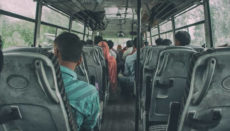
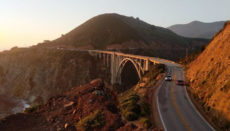

Sorry, the comment form is closed at this time.